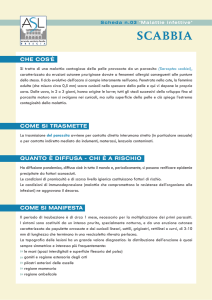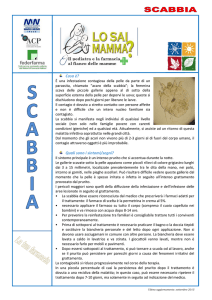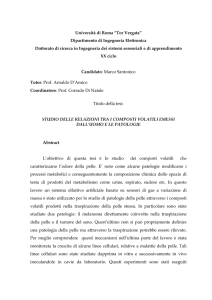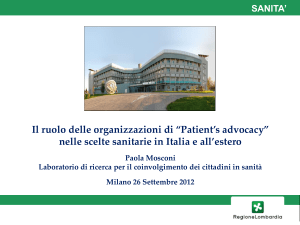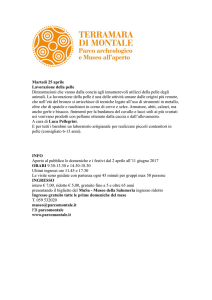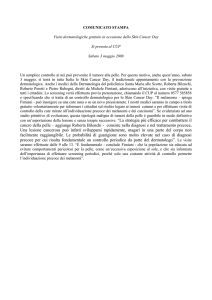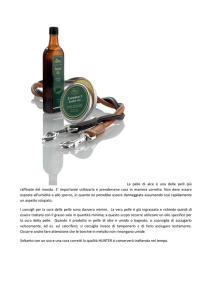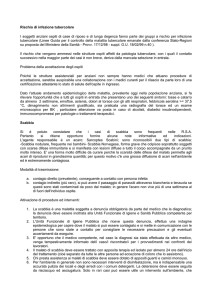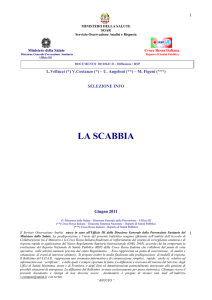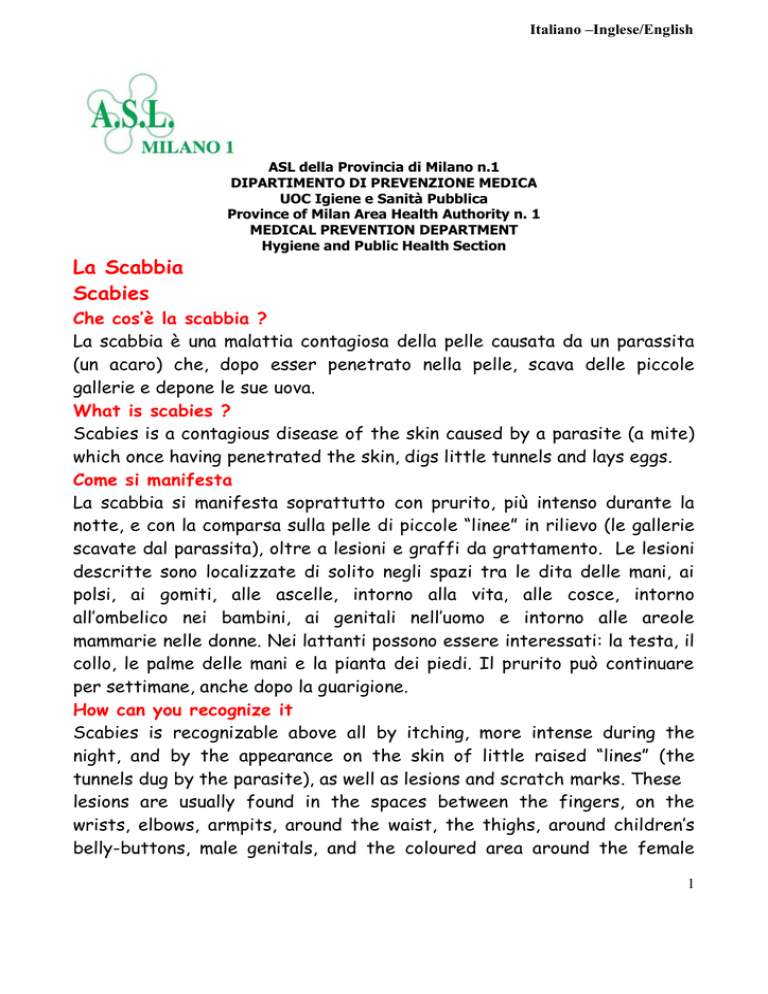
Italiano –Inglese/English
ASL della Provincia di Milano n.1
DIPARTIMENTO DI PREVENZIONE MEDICA
UOC Igiene e Sanità Pubblica
Province of Milan Area Health Authority n. 1
MEDICAL PREVENTION DEPARTMENT
Hygiene and Public Health Section
La Scabbia
Scabies
Che cos’è la scabbia ?
La scabbia è una malattia contagiosa della pelle causata da un parassita
(un acaro) che, dopo esser penetrato nella pelle, scava delle piccole
gallerie e depone le sue uova.
What is scabies ?
Scabies is a contagious disease of the skin caused by a parasite (a mite)
which once having penetrated the skin, digs little tunnels and lays eggs.
Come si manifesta
La scabbia si manifesta soprattutto con prurito, più intenso durante la
notte, e con la comparsa sulla pelle di piccole “linee” in rilievo (le gallerie
scavate dal parassita), oltre a lesioni e graffi da grattamento. Le lesioni
descritte sono localizzate di solito negli spazi tra le dita delle mani, ai
polsi, ai gomiti, alle ascelle, intorno alla vita, alle cosce, intorno
all’ombelico nei bambini, ai genitali nell’uomo e intorno alle areole
mammarie nelle donne. Nei lattanti possono essere interessati: la testa, il
collo, le palme delle mani e la pianta dei piedi. Il prurito può continuare
per settimane, anche dopo la guarigione.
How can you recognize it
Scabies is recognizable above all by itching, more intense during the
night, and by the appearance on the skin of little raised “lines” (the
tunnels dug by the parasite), as well as lesions and scratch marks. These
lesions are usually found in the spaces between the fingers, on the
wrists, elbows, armpits, around the waist, the thighs, around children’s
belly-buttons, male genitals, and the coloured area around the female
1
nipples. In unweaned babies (still breast-feeding), lesions may be found
on the head, the neck, the palms of the hands and the soles of the feet.
Itching may continue for weeks, even after recovery.
Come si trasmette
Il contagio avviene è per contatto diretto, pelle contro pelle, da una
persona malata ad una persona sana. Più raramente si trasmette in modo
indiretto tramite la biancheria da letto, i vestiti o gli asciugamani
utilizzati poco tempo prima da persone ammalate di scabbia : il parassita
infatti non sopravvive a lungo lontano dal corpo umano.
How is it transmitted
Contagion takes place through direct contact, skin against skin, between
a sick person and a healthy one. It is more rarely transmitted indirectly
through bed linen, clothes or towels recently used by a scabies sufferer:
in actual fact, the parasite cannot survive for long away from a human
body.
Cosa fare quando ci si ammala
Quando compaiono lesioni della pelle accompagnate da intenso prurito è
importante rivolgersi al più presto ad un medico.
Se viene fatta diagnosi di scabbia è necessario sottoporsi in modo
scrupoloso al trattamento con l’apposito farmaco e mettere in atto tutte
le misure di carattere igienico raccomandate, in particolare:
- eseguire una pulizia accurata dell’ambiente dove vive il malato,
- lavare a caldo (almeno a 60°) la biancheria personale, le lenzuola e
federe e gli asciugamani utilizzati dal malato.
- i materassi, i cuscini e gli indumenti personali che non possono essere
lavati ad alte temperature, vanno messi in sacchetti chiusi e non
utilizzati per almeno 7 giorni, poi esposti all’aria aperta, prima di
essere riutilizzati (i parassiti non sopravvivono oltre 3 – 4 giorni se
non sono a contatto con la pelle).
La scabbia non è una malattia grave, ma è alto il rischio di contagiare
altre persone, in particolare gli altri componenti della famiglia ai quali
viene consigliato di effettuare lo stesso trattamento del malato, pur non
avendo disturbi.
What to do if you become ill
When skin lesions appear together with intense itching, it is extremely
important to go to a doctor as quickly as possible.
2
If scabies is diagnosed, it will be necessary to undergo treatment as
thoroughly as possible with special medicine, and follow exactly all the
hygiene measures recommended, in particular:
- carry out a thorough cleaning of the patient’s living area,
- put all personal linen, sheets, pillow cases and towels used by the
patient through a hot wash (at least 60°).
- mattresses, pillows and personal items that cannot be washed at high
temperature should be placed in sealed bags and not used for at least
7 days, then exposed to fresh air, before being used again (the
parasites cannot survive for more than 3 – 4 days if not in contact
with skin).
Scabies is not a serious illness, but the risk of passing it on to other
people is high, particularly other family members, who are advised to
carry out the same hygiene measures as the patient, in order to avoid
suffering from the same problem.
Cosa si fa se il malato frequenta la scuola o lavora
Se il malato frequenta collettività, come la scuola o il lavoro, dovrà
sospendere la frequenza per sottoporsi alle cure del caso e riprendere a
frequentare solo dopo il termine della cura. Le persone che hanno avuto
contatti stretti con il malato (famigliari, conviventi) dovranno essere
sottoposti a visita medica e, se necessario, alla cura. L’ammalato non viene
più considerato contagioso dopo il termine della terapia con l’apposito
farmaco. Se però i sintomi persistono,occorre rivolgersi nuovamente al
medico.
What to do if the patient goes to school or work
If the patient has social contact, such as a school or work environment,
they should stop while undergoing the treatment, and start again only
after the end of the treatment. Those people who have had close contact
with the patient (family members, other people living in the same house)
should undergo a medical examination, and, if necessary, also the
treatment. The patient will no longer be considered contagious after
treatment with the appropriate medicine. However, if symptoms persist,
it will be necessary to return to the doctor.
3
4


